
Prince Igor is an opera in four acts with a prologue, written and composed by Alexander Borodin. The composer adapted the libretto from the Ancient Russian epic The Lay of Igor's Host, which recounts the campaign of Rus' prince Igor Svyatoslavich against the invading Cuman ("Polovtsian") tribes in 1185. He also incorporated material drawn from two medieval Kievan chronicles. The opera was left unfinished upon the composer's death in 1887 and was edited and completed by Nikolai Rimsky-Korsakov and Alexander Glazunov. It was first performed in St. Petersburg, Russia, in 1890.

Nikolai Andreyevich Rimsky-Korsakov was a Russian composer, a member of the group of composers known as The Five. He was a master of orchestration. His best-known orchestral compositions—Capriccio Espagnol, the Russian Easter Festival Overture, and the symphonic suite Scheherazade—are staples of the classical music repertoire, along with suites and excerpts from some of his 15 operas. Scheherazade is an example of his frequent use of fairy-tale and folk subjects.

The Five, also known as the Russian Five, MightyHandful, The Mighty Five, and the New Russian School, were five prominent 19th-century Russian composers who worked together to create a distinct national style of classical music: Mily Balakirev, César Cui, Modest Mussorgsky, Nikolai Rimsky-Korsakov and Alexander Borodin. They lived in Saint Petersburg and collaborated from 1856 to 1870.

Mily Alexeyevich Balakirev was a Russian composer, pianist, and conductor known today primarily for his work promoting musical nationalism and his encouragement of more famous Russian composers, notably Pyotr Ilyich Tchaikovsky. He began his career as a pivotal figure, extending the fusion of traditional folk music and experimental classical music practices begun by composer Mikhail Glinka. In the process, Balakirev developed musical patterns that could express overt nationalistic feeling. After a nervous breakdown and consequent sabbatical, he returned to classical music but did not wield the same level of influence as before.

Stepan Timofeyevich Razin, known as Stenka Razin, was a Cossack leader who led a major uprising against the nobility and tsarist bureaucracy in southern Russia in 1670–1671.
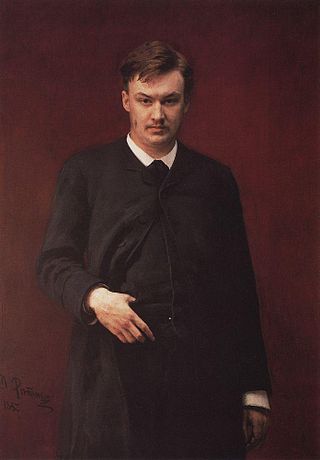
Alexander Konstantinovich Glazunov was a Russian composer, music teacher, and conductor of the late Russian Romantic period. He was director of the Saint Petersburg Conservatory between 1905 and 1928 and was instrumental in the reorganization of the institute into the Petrograd Conservatory, then the Leningrad Conservatory, following the Bolshevik Revolution. He continued as head of the Conservatory until 1930, though he had left the Soviet Union in 1928 and did not return. The best-known student under his tenure during the early Soviet years was Dmitri Shostakovich.

The "Song of the Volga Boatmen" is a well-known traditional Russian song collected by Mily Balakirev and published in his book of folk songs in 1866. It was sung by burlaks, or barge-haulers, on the Volga River. Balakirev published it with only one verse. The other two verses were added at a later date. Ilya Repin's famous painting Barge Haulers on the Volga depicts such burlaks in Tsarist Russia toiling along the Volga.

Mitrofan Petrovich Belyayev was an Imperial Russian music publisher, outstanding philanthropist, and the owner of a large wood dealership enterprise in Russia. He was also the founder of the Belyayev circle, a society of musicians in Russia whose members included Nikolai Rimsky-Korsakov, Alexander Glazunov and Anatoly Lyadov. His surname is often transliterated as Belaieff or Belayev. In 1886 the Russian painter Ilya Repin made a portrait of Belyayev.
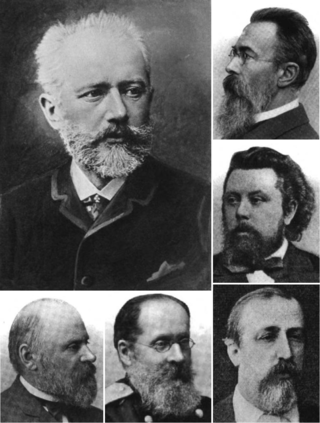
In mid- to late-19th-century Russia, Pyotr Ilyich Tchaikovsky and a group of composers known as The Five had differing opinions as to whether Russian classical music should be composed following Western or native practices. Tchaikovsky wanted to write professional compositions of such quality that they would stand up to Western scrutiny and thus transcend national barriers, yet remain distinctively Russian in melody, rhythm and other compositional characteristics. The Five, made up of composers Mily Balakirev, Alexander Borodin, César Cui, Modest Mussorgsky, and Nikolai Rimsky-Korsakov, sought to produce a specifically Russian kind of art music, rather than one that imitated older European music or relied on European-style conservatory training. While Tchaikovsky himself used folk songs in some of his works, for the most part he tried to follow Western practices of composition, especially in terms of tonality and tonal progression. Also, unlike Tchaikovsky, none of The Five were academically trained in composition; in fact, their leader, Balakirev, considered academicism a threat to musical imagination. Along with critic Vladimir Stasov, who supported The Five, Balakirev attacked relentlessly both the Saint Petersburg Conservatory, from which Tchaikovsky had graduated, and its founder Anton Rubinstein, orally and in print.

Nikolai Rimsky-Korsakov composed his Piano Concerto in C-sharp minor, Op. 30, between 1882 and 1883. It was first performed in March 1884 at one of Mily Balakirev's Free Music School concerts in St. Petersburg.

Antar is a composition for symphony orchestra in four movements by the Russian composer Nikolai Rimsky-Korsakov. He wrote the piece in 1868 but revised it in 1875 and 1891. He initially called the work his Symphony No. 2. He later reconsidered and called it a symphonic suite. It was first performed in March 1869 at a concert of the Russian Musical Society.
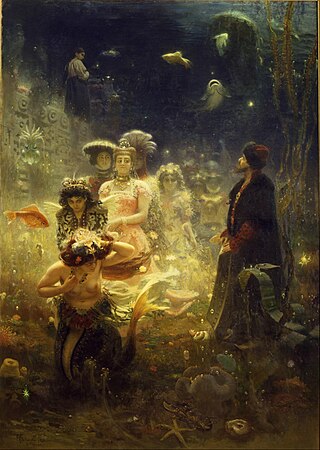
Sadko, Op. 5, is a Tableau musical, or Musical picture, by Nikolai Rimsky-Korsakov, written in 1867 and revised in 1869 and 1892. It is sometimes called the first symphonic poem written in Russia. It was first performed in 1867 at a concert of the Russian Musical Society (RMS), conducted by Mily Balakirev. Rimsky-Korsakov later wrote an opera of the same name which quotes freely from the earlier work. From the tone poem the composer quoted its most memorable passages in the opera, including the opening theme of the swelling sea, and other themes as leitmotifs – he himself set out to "utilize for this opera the material of my symphonic poem, and, in any event, to make use of its motives as leading motives for the opera".

Nikolai Rimsky-Korsakov composed his Symphony No. 1 in E minor, Op. 1, between 1861 and 1865 under the guidance of Mily Balakirev. Balakirev also premiered the work at a concert of the Free Music School in December 1865. Rimsky-Korsakov revised the work in 1884.
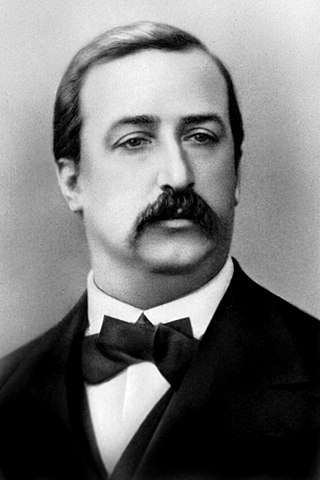
Symphony No. 2 in B minor by Alexander Borodin was composed intermittently between 1869 and 1876. It consists of four movements and is considered the most important large-scale work completed by the composer himself. It has many melodic resemblances to both Prince Igor and Mlada, two theatre works that diverted Borodin's attention on and off during the six years of composition.
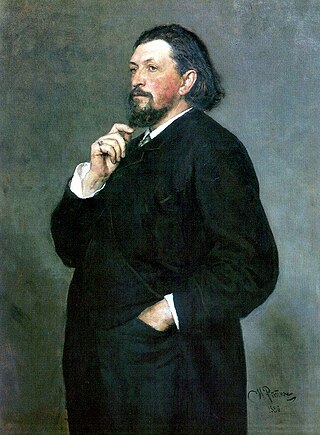
The Russian Symphony Concerts were a series of Russian classical music concerts hosted by timber magnate and musical philanthropist Mitrofan Belyayev in St. Petersburg as a forum for young Russian composers to have their orchestral works performed. While a number of works by these composers were performed, pieces written by composers of the previous generation such as Nikolai Rimsky-Korsakov and Mily Balakirev were also played there.
Alexander Glazunov wrote his Symphony No. 1 in E major, Op. 5, in 1881, when he was 16 years old. It was premiered the following year in St. Petersburg. It is known as his Slavonian Symphony.
The Belyayev circle was a society of Russian musicians who met in Saint Petersburg, Russia between 1885 and 1908, and whose members included Nikolai Rimsky-Korsakov, Alexander Glazunov, Vladimir Stasov, Anatoly Lyadov, Alexander Ossovsky, Witold Maliszewski, Nikolai Tcherepnin, Nikolay Sokolov, Alexander Winkler among others. The circle was named after Mitrofan Belyayev, a timber merchant and amateur musician who became a music philanthropist and publisher after hearing the music of the teenage Glazunov.

Leonid Mikhailovich Kharitonov was a Soviet and Russian bass-baritone singer. He was honored with People's Artist of the RSFSR and Honored Artist of RSFSR. In the West he was noted for his 1965 video of The Song of the Volga Boatmen.

Pyotr Ilyich Tchaikovsky's relations with the group of composers known as the Belyayev circle, which lasted from 1887 until Tchaikovsky's death in 1893, influenced all of their music and briefly helped shape the next generation of Russian composers. This group was named after timber merchant Mitrofan Belyayev, an amateur musician who became an influential music patron and publisher after he had taken an interest in Alexander Glazunov's work. By 1887, Tchaikovsky was firmly established as one of the leading composers in Russia. A favorite of Tsar Alexander III, he was widely regarded as a national treasure. He was in demand as a guest conductor in Russia and Western Europe, and in 1890 visited the United States in the same capacity. By contrast, the fortunes of the nationalistic group of composers known as The Five, which preceded the Belyayev circle, had waned, and the group had long since dispersed; of its members, only Nikolai Rimsky-Korsakov remained fully active as a composer. Now a professor of musical composition and orchestration at the Saint Petersburg Conservatory, Rimsky-Korsakov had become a firm believer in the Western-based compositional training that had been once frowned upon by the group.

















